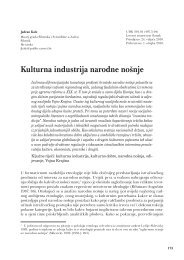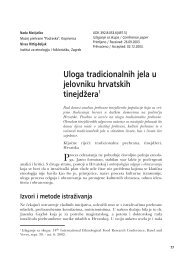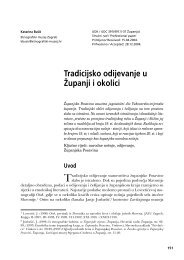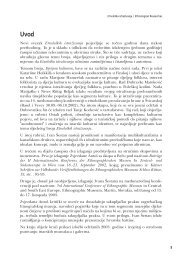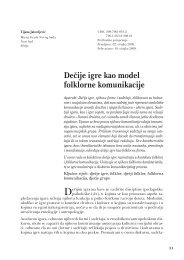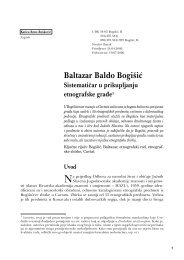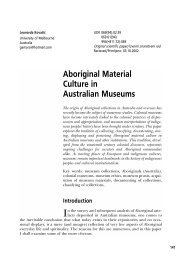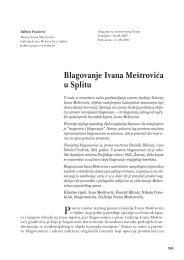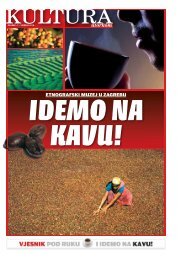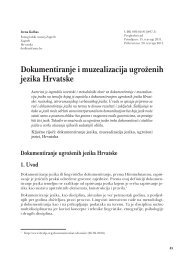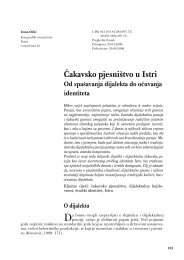Etnoloska istrazivanja / Ethnological researches - EMZ
Etnoloska istrazivanja / Ethnological researches - EMZ
Etnoloska istrazivanja / Ethnological researches - EMZ
You also want an ePaper? Increase the reach of your titles
YUMPU automatically turns print PDFs into web optimized ePapers that Google loves.
Maja Cepetić, Josip Matker Amici hereditatis – udruga građana u službi muzejadok se u njihovoj organizaciji, uz suradnju s hrvatskom sekcijom ECOVAST-a (Europskovijeće za razvoj sela i malih gradova), u studenom 2011. u Ivanić-Gradu planirameđunarodni stručni skup “Modeli upravljanja procesima obnove i razvoja povijesnihgradova – Primjer Ivanić-Grada: mogućnosti revitalizacije i obnove starog Ivanića”.Godine 2010. pokrenuta je akcija prikupljanja starih predmeta, dokumenata i fotografijas ciljem da se formira osnova za jednu od budućih zbirki muzeja jer, prema Zakonuo Muzejima (čl. 17), za osnivanje muzeja ili galerije mora postojati muzejska građai pripadajuća muzejska dokumentacija, prostor, oprema i sredstva za rad te stručnoosoblje. Do sada prikupljeni predmeti većim su dijelom etnografskog karaktera (ćupovi,tkalački stan, korita, tradicijski drveni namještaj itd.). Predmeti se po preuzimanjudokumentiraju prema važećim standardima muzejske dokumentacije te pohranjujuu adekvatni prostor (već spomenuti prostor Udruge). Iako na području Gradapostoji nekolicina velikih obiteljskih zbirki uistinu vrijednih pažnje, razlog koji je potaknuona akciju prikupljanja starih predmeta, dokumenata i fotografija bio je uništavanjevrijedne baštine, prije svega etnografske, i to ponajviše zbog neznanja vlasnikao vrijednosti i važnosti predmeta ili pak njihove namjere da očiste životni prostorod nepotrebnih stvari bacajući ih u otpad. S mišlju da je bolje sačuvati za budućegeneracije, nego nepovratno uništiti, ova će akcija trajati sve do trenutka osnivanjamuzeja koji kao ustanova za jednu od svojih funkcija ima upravo prikupljanje i dokumentiranjezajedničkih vrijednosti.Popisivanje etnografske zbirke obitelji KezeleZa “Udrugu građana Prijatelji baštine – Amici hereditatis”, pored održavanja raznihpredavanja i izložbi, jedan je od većih projekata i popisivanje izložbene građe, tj. predmetakoji se nalaze u privatnim zbirkama. Najveća među njima jest etnografska zbirkaobitelji Kezele koja se nalazi u nekoliko gospodarskih zgrada i u restoranu na njihovuimanju u Šumečanima nedaleko Ivanić-Grada. Cilj je ovog popisivanja dobivanjestatusa lokalne, pa čak i regionalne zbirke. Popisivanje etnografske građe započeto jeu ljeto 2010. godine, te je nastavljeno u jesen (Slika 3). Do sada je popisano dvjestotinjakpredmeta koji pripadaju postolarskoj radionici te posude za preradu mliječnihproizvoda. Najveći dio zbirke čine ćupovi kojih ima preko petsto, te kao cjelina činenajveći keramički korpus jedne zbirke u županiji, a vjerojatno i u Hrvatskoj (Slika 4).Većina predmeta koji se nalaze u zbirci obiteljsko je naslijeđe ili su u zbirku pribavljenikupnjom. Sama zbirka čini cjelinu koja pripada regionalnom području Moslavine,tj. gotovo svi predmeti korišteni su na području Moslavine, te time zbirka uistinudobiva na važnosti kao regionalna baština zavičaja. Uz keramičke i drvene predmete,treba istaknuti i predmete od raznih metala, pri čemu se podrazumijevaju dijelovikovačnice i razne metalne posude. Osim predmeta koji su bili sastavni dio svakogagospodarstva, ima i dosta onih koji su imali dekorativnu funkciju ili su služili zarazonodu u slobodno vrijeme.299
Etnološka istraživanja 16/<strong>Ethnological</strong> Researches 16Budući da su neki članovi Udruge studenti na Odsjeku za etnologiju i kulturnu antropologijuFilozofskog fakulteta Sveučilišta u Zagrebu, oni su bili zaduženi za popisivanjegrađe. Članovi Udruge potražili su pomoć i od stručnih osoba u Etnografskommuzeju u Zagrebu. Tako je ostvaren kontakt i suradnja s kustosicom MarijomŽivković koja je posjetila zbirku i čija je stručna pomoć uvelike pomogla pri popisivanju.Uz tzv. “domaće” studente, u popisivanju su sudjelovali i ostali studenti s preddiplomskogi diplomskog studija etnologije i kulturne antropologije. Cilj ovakvoga radabio je upoznati studente iz svih krajeva Hrvatske sa značenjem lokalne baštine, te provestidio teorijske nastave u praksi (Slika 5). 4 Studentice i studenti najprije su se upoznalis regijom u kojoj se provodi opisivanje, te s važnošću same zbirke. Nakon nekolikodogovora uslijedio je izlazak na teren gdje se u dva termina, ljeto i jesen, u razdobljuod tjedan dana provodilo popisivanje. Građu su popisivali studenti uz pomoćstarijih kolega s Fakulteta. Pri tome su se koristila prijašnja iskustva s terenskoga rada,kao i priručnik Upute za čuvanje etnografskih zbirki kako bi što bolje razumjeli i sustavnoproveli popisivanje (Mlinar, Antoš, 2004: 7). Za popisivanje nije korišten muzejskiprogram za evidenciju predmeta (npr., M++), već su podaci upisivani u word dokumenti navođeni pod rednim brojevima. Isto tako, pristupilo se i fotografiranju predmeta,uz poštivanje protokola unošenja podataka. Tako je, primjerice, na najmanjevidljivo mjesto na predmetu napisan inventarni broj, dok je prilikom slikanja predmetana neutralnoj podlozi broj istaknut sa strane. Time je olakšano spajanje dokumentas opisom predmeta i slike u jedinstveni dokument. Predmeti koji se nalaze urestoranu obitelji Kezele, a koji služe kao izložbeni eksponati, planiraju se popisati nakraju, dok će se pribor koji se koristi u kućanstvu popisati tijekom ljeta 2011. Razlogsu takvoga tempa rada studentske obaveze. Udruga je, naime, u ovaj projekt uključilastudente kako one kojima je to buduća struka, tako i one koji studiraju povijest ipovijest umjetnosti.Etnografska građa koja se nalazi u zbirci obitelji Kezele ima veliku važnost za šire područje.Trudom obitelji na jednom se mjestu nalaze predmeti koji se vežu uz zanatskudjelatnost stolara, postolara, keramičara, pečenjara, kao i najjednostavniji predmeti izkućanstva. Važnost dokumentacije također je velika, jer se pomoću popisa stručnjacimogu lakše snalaziti u samoj zbirci. Stalno surađujući s obitelji Kezele, Udruga je pripostavljanju izložbe “Obrtnici starog Ivanića” koristila i nekolicinu predmeta iz njihoveetnografske zbirke. Kako nema vlastitoga muzejskog prostora, “Udruga građanaPrijatelji baštine – Amici hereditatis” značaj regije i kraja ističe tako da na izložbenimprogramima često predstavlja etnografsku zbirku obitelji Kezele u Šumečanima.4Prvi takav projekt proveden je sa studentima “bolonjskog sustava” u gradu Bakru od 30. srpnja do 6.kolovoza 2007. u organizaciji Hrvatskog etnološkog društva i Odsjeka za etnologiju i kulturnu antropologijuFilozofskog fakulteta Sveučilišta u Zagrebu pod stručnim vodstvom prof. dr. sc. Branka Đakovića,a kasnije su uslijedila samostalna popisivanja.300
Maja Cepetić, Josip Matker Amici hereditatis – udruga građana u službi muzejaZaključakDjelovanje “Udruge građana Prijatelji baštine – Amici hereditatis” svakako je vrijedno,jer je ona jedan od čimbenika koji utječe na oblikovanje identiteta lokalnog stanovništva,i to ponajprije brigom o materijalnoj i nematerijalnoj lokalnoj baštini i njezinomočuvanju za buduće generacije. Niz akcija i događaja koje Udruga upriličuje govoreupravo tome u prilog. Svoj je rad u početku Udruga usmjerila na informiranje građanao važnosti lokalne baštine kako materijalne tako i nematerijalne. Volonterskimradom članova ostvarene su različite izložbe koje su za cilj imale osvijestiti građanstvoo važnosti lokalne baštine. Članovi Udruge pokrenuli su popisivanje i skupljanjetradicijskih predmeta za postav muzeja u nastajanju, a pri tome im pomažu i studentiOdsjeka za etnologiju i kulturnu antropologiju Filozofskog fakulteta u Zagrebu. Dosada je ostvarena suradnja s hrvatskom sekcijom ECOVAST-a i HED-om (Hrvatskimetnološkim društvom). Nekoliko članova Udruge svoj je stručni rad posvetio problemuočuvanja baštine, predstavljajući ga i na međunarodnim stručnim skupovima.LiteraturaBićanić, Rudolf. 1951. Doba manufakture u Hrvatskoj i Slavoniji: (1750-1860). Zagreb:Izdavački zavod Jugoslavenske akademije znanosti i umjetnosti.Kruhek, Milan. 1978. Ivanić-Grad. Ivanić-Grad: Narodno sveučilište Ivanić-Grad.Maroević, Ivo. 1993. Uvod u muzeologiju. Zagreb: Zavod za informacijske studije.Mavar, Zofia, ur. 2008. Ivanić-Grad, Građevine kulturno-povijesnih vrijednosti napodručju povijesne jezgre, katalog. Zagreb: Ministarstvo kulture.Mlinar, Ana; Antoš, Zvjezdana. 2004. Upute za čuvanje etnografskih zbirki. Zagreb:Hrvatsko etnološko društvo.Zakon o muzejima: http://narodne-novine.nn.hr/clanci/sluzbeni/269487.html(25.05.2011.)http://www.prijatelji-bastine.hr/o-udruzi/osnovne-djelatnosti-udruge (25.05.2011.)301
Etnološka istraživanja 16/<strong>Ethnological</strong> Researches 164.14.24.34.54.4302
Maja CepetićUniversity of RijekaFaculty of Humanities and Social SciencesRijekaCroatiamcepetic@ffri.hrJosip MatkerTrebovecCroatiajmatker@vodatel.netUDK 061.23.39](497.521 Ivanić-Grad)AppendiceReceived: May 13, 2011Accepted: May 27, 2011Amici hereditatis – Civic Association inthe Service of MuseumSince there is no museum in the area of Otok Ivanić, the “Civic Association Prijateljibaštine – Amici hereditatis” was founded in 2005, with the main aim to raise awarenessof the local community of the importance to protect local heritage and tradition.Another aim of the Association - to raise awareness of its own cultural identity is realisedthrough different actions and manifestations. The heritage in the area of Ivanić-Grad has outstanding local importance, and the majority of the existing collectionsare privately owned and of ethnographic character thus creating the basis of a futuremuseum. Registration of the material of a private ethnographic collection is underway in cooperation with the Croatian <strong>Ethnological</strong> Society and the Department ofEthnology and Cultural Anthropology of the Faculty of Humanities and Social Sciencesin Zagreb.Key words: heritage, identity, Amici hereditatis , civic association,museum, Ivanić-Grad, Croatian <strong>Ethnological</strong> Society, Kezele collectionIntroduction – on heritage and identityCultural identity is undoubtedly one of the important elements of every society andevery community. The amount of effort needed to raise awareness towards it in a smalllocal community without a museum, but with a rich ethnographic and other heritagewill be presented through the activity of the “Civic Association Prijatelji baštine –Amici hereditatis” in the area of the town of Ivanić-Grad.There exist numerous definitions of heritage and they all include material heritage(buildings, monuments, artefacts, archaeological sites, etc.) and non-material heritage(customs, beliefs, traditions, languages, etc.) inherited from the past, in some forms,303
Etnološka istraživanja 16/<strong>Ethnological</strong> Researches 16tangible or intangible and documenting that past. When the so-called tangible andintangible expressions of heritage are placed locally, they result in cultural traditionscharacteristic for a certain local community, and are called local heritage.The concrete definition of heritage objects by Maroević (1993: 120) states that “a heritageobject is the object that by its material and form documents reality in which itwas created, in which it lived and with which it entered the present. Heritage objectshave rich layers of meaning by which they communicate messages of the past into thepresent and protect them for the future.” In this context, identity as a part of the messagethe heritage contains becomes an element of cognition of the existence, of one’sown historical roots and structures that are deep in us, and in that way, whether wewant it or not, they determine our allegiance to the state, homeland, place, race, civilisation,culture, religion or any other form of shaped consciousness. In the ambiancesof cultural heritage or among objects that represent heritage we come to knowthe similarities and differences determining thus our own identities. Because of thatcultural identity, the creation of which enables the contact with heritage, is irreplaceable,for an individual as well as for the community as a whole (Maroević, 1993: 99).Accordingly, the “Civic Association Prijatelji baštine - Amici hereditatis” can be oneof the factors that will affect the shaping of local identity of the area where it works.The heritage of Otok IvanićThe area of Otok Ivanić 1 is rich in cultural heritage that dates back to the MiddleAges. Big mediaeval church centres, today Kloštar Ivanić and Križ, belonged to theZagreb Bishopric from the very beginning, i.e. from its founding in the last decade ofthe 11 th century. Even today, in the foundations of sacral entities of these places andthe surrounding cultural landscape, traces can be noticed of the oldest history thatis still today not recognised enough. The current Ivanić-Grad, although it has probablyexisted as a settlement in the High Middle Ages, started developing intensivelyin the 15 th century, to reach its full importance at the times of the Ottoman invasionat the beginning of the 16 th century when a classic fortification against the Ottomanswas built, the material traces of which are not visible today. After the danger fromthe Ottomans disappeared two centuries later, the fortification still remains at a militarybase at the frontier with the Ottoman empire, and Ivanić gets new possibilitiesfor economic and cultural development. Peaceful economic development within thefrontiers enabled Ivanić to become a strong crafts’ and well-known trade centre. Thisdefinitely raised the level of living in comparison to the neighbouring settlements.1Otok Ivanić is the name used in several historical documents, and geographically it spans over the areadefined by rivers Lonja, Glogovnica and Česma. The term geographically determines the western Moslavina.In the contemporary administrative sense these are the areas of the town of Ivanić-Grad, municipalityof Kloštar Ivanić and Municipality of Križ.304
Maja Cepetić, Josip Matker Amici hereditatis – Civic Association in the Service of Museumprogramme on local heritage. During the last “Museum Night” organised was a walkthrough old Ivanić, with well-known historical personalities from Ivanić.To raise awareness about heritage issues of the Otok Ivanić area in the greater professionalcommunity, the members of the Association gave presentations at several professionalmeetings. They are also planning to organise, in cooperation with the Croatiansection of ECOVAST (the European Council for the Village and Small Town), aninternational professional meeting „Management Models of Restoration and DevelopmentProcesses of Historic Towns – the Example of Ivanić-Grad: Possibilities of Revitalisationand Restoration of Old Ivanić”, to be held in Ivanić-Grad in November 2011.In the year 2010 initiated was the action to collect old items, documents and photographswith the aim to create the basis for one of the future museum collections, becauseaccording to the Law on Museums (article 17), museum material and the associatedmuseum documentation, space, equipment and professional staff must exist in orderto establish a museum. The objects collected up to now are mainly ethnographic(jars, a loom, troughs, traditional wooden furniture, etc). On receipt, the objects aredocumented according to the currently valid museum documentation standards andthen they are stored appropriately (on the already mentioned premises of the Association).Although there are several notable family collections in the town, the collectionof old objects, documents and photographs was initiated because heritage, primarilyethnographic, was destroyed, most often due to owner’s ignorance of the valueand importance of an object or their intention to clean up their living spaces of unnecessarythings by throwing them in the rubbish. With the thought that it is betterto protect for future generations than to destroy irretrievably, this action will go ontill the establishment of the museum, one of the function of which is collection anddocumenting common values.Registering ethnographic collection of the Kezele familyIn addition to organising different lectures and exhibitions, one of the great projectsof the “Association Prijatelji baštine - Amici hereditatis” is the registration of exhibitionmaterial, i.e. objects from private collections. The biggest among them is ethnographiccollection of the Kezele family, situated in several farm buildings and the restauranton their property in Šumečani, in the vicinity of Ivanić-Grad. The aim of thisregistration is obtaining of the status of local and even regional collection. The registrationof ethnographic collection started in the summer of 2010, and continued in autumn(Picture 3). Some two hundred objects belonging to shoemaking workshop andcontainers for milk processing were registered up to now. Five hundred jars make upthe major part of the collection, thus making the greatest pottery corpus in a collectionin the county, and probably in the whole of Croatia (Picture 4). The majority ofobjects in the collection are a family legacy or they were bought. The collection itselfbelongs to the region of Moslavina, i.e. almost all the objects were used in the region307
Etnološka istraživanja 16/<strong>Ethnological</strong> Researches 16of Moslavina, and this makes it especially important as the regional homeland heritage.In addition to pottery and wooden objects, objects of various metals, like partsof a blacksmith’s shop and different metal containers also have to be singled out. Inaddition to objects that were part of any household, there is a lot of those that had adecorative function or were used for entertainment in free time.Some members of the Association are students at the Department of Ethnology andCultural Anthropology of the Faculty of Humanities and Social Sciences in Zagrebso they were in charge of the registration of the material. Members of the Associationsought help from the professional staff of the Ethnographic Museum in Zagreb whichresulted in the cooperation with the curator Marija Živković who visited the collectionand her professional aid was a great help during registration. Together with the “domestic”students, other graduate and postgraduate students of ethnology and culturalanthropology also participated in the registration. The aim of this work was to raiseawareness about the importance of local heritage in students from all parts of Croatiaand to perform field education (Picture 5). 4 First of all the students got acquaintedwith the region where the registration was performed and with the importance ofthe collection. After several discussions two field trips, in summer and autumn, eachlasting a week, were devoted to registration. Students registered the material with thehelp of older colleagues from the Faculty. For better understanding and more systematicregistration previous field work experiences were used as well as the manualInstructions for the Protection of Ethnographic Collections (Mlinar, Antoš, 2004: 7) Nomuseum program for object registration (like M++) was used, but the data were enteredinto a Word document under ordinal numbers. The objects were photographedat the same time, respecting the data input protocol. Thus for instance, the inventorynumber was put in the least visible place on the object, and during photographingthe number was brought out on the side on a neutral surface. This facilitated thelinking of document and the object description into a unique document on a neutralbasis. Objects that are on display in the Kezele restaurant will be registered in theend, and the utensils used in the household will be registered during the summer of2011. The rate of the work is dictated by students’ commitments. Namely, the Associationincluded into this project the students who will become future professionals inthis field as well students of history and history of art.Ethnographic material in the Kezele family collection is very important for the greaterarea. Family’s efforts gathered objects related to crafts of joiners, shoemakers, potters,meat baker, as well as the simplest household objects. Documentation is also veryimportant, because professionals can easily find their way in the collection. Constantlycooperating with the Kezele family, the Association used a couple of objects fromtheir ethnographic collection in the exhibition “Craftsmen of Old Ivanić“. Since it doesnot have its own museum, the “Association Prijatelji baštine - Amici hereditatis” often4The first such project with the students of the „Bologna system“ in the city of Bakar from 30 th July to5 th August was organised by the Croatian <strong>Ethnological</strong> Society and the Department of Ethnology andCultural Anthropology of the Faculty of Humanities and Social Sciences in Zagreb, under the professionalguidance of prof. Branko Đaković, Ph.D., and by individual registrations followed later.308



